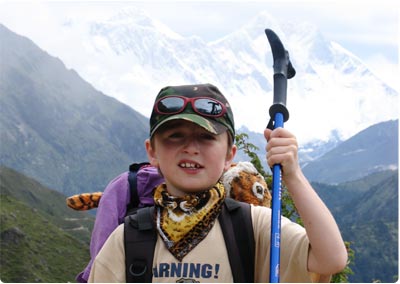
A 9 years old courageous boy trek up to Everest
Base Camp
Whether you begin
your trek at a roadhead or fly into a remote
mountain airstrip, a large part of it will be
in the Middle Hills region at elevations between
500 and 3000 metres. In this region, there are
always well-developed trails through villages
and across mountain passes. Even at high altitudes
there are intermittent settlements used during
summer by shepherds, so the trails, though often
indistinct, are always there. You can easily
travel on any trail without the aid of ropes
or mountaineering skills. There are rare occasions
when there is snow on the trail, and on some
high passes it might be necessary to place a
safety line for your companions or porters if
there is deep snow. Still, alpine techniques
are almost never used on a traditional trek.
Anyone who has walked extensively in the mountains
has all the skills necessary for an extended
trek in Nepal.
Though some treks
venture near glaciers, and even cross the foot
of them, most treks do not allow the fulfilment
of any Himalayan mountaineering ambitions. Nepal's
mountaineering regulations allow trekkers to
climb 18 specified peaks with a minimum of formality,
but you must still make a few advance arrangements
for such climbs. Many agents offer so-called
climbing treks which include the ascent of one
of these peaks as a feature of the trek. There
are a few peaks that, under ideal conditions,
are within the resources of individual trekkers.
A climb can be arranged in Kathmandu if conditions
are right, but a climb of one of the more difficult
peaks should be planned well in advance.
A Trek
Requires Physical Effort
A trek is physically demanding because of its
length and the almost unbelievable changes in
elevation. During the 300-km trek from Jiri
to Everest base camp and return, for example,
the trail gains and loses more than 9000 metres
of elevation during many steep ascents and descents.
On most treks, the daily gain is less than 800
metres in about 15 km, though ascents of as
much as 1200 metres are possible on some days.
You can always take plenty of time during the
day to cover this distance, so the physical
exertion, though quite strenuous at times, is
not sustained. You also can stop frequently
and take plenty of time for rest.
Probably the only
physical problem that may make a trek impossible
is a history of knee problems on descents. In
Nepal the descents are long, steep and unrelenting.
There is hardly a level stretch of trail in
the entire country. If you are an experienced
walker and often hike 15 km a day with a pack,
a trek should prove no difficulty. You will
be pleasantly surprised at how easy the hiking
can be if you only carry a light backpack and
do not have to worry about meal preparation.
Previous experience
in hiking and living outdoors is, however, helpful
as you make plans for your trek. The first night
of a month-long trip is too late to discover
that you do not like to sleep in a sleeping
bag. Mountaineering experience is not necessary,
but you must enjoy walking.
Trekking in Everest
Region |
| Everest Region is also known as the Solu Khumbu is known around the world as the famous home of the world's highest mountain. Mt. Everest, or Sagarmatha as the Nepalese call it, rises 8,848 meters into the sky. The hike to the base camp attracts trekkers from all over the globe.
The attractions are the majestic mountains, the villages in the high mountain valleys, the associated monasteries, and the legendary inhabitants.
|
|
|
Trekking in Annapurna
Region |
| This region is the popular in the world. we see the lot's mountain views Annapurna
south(7219M ),Annapurna I (8091M), Annapurna II (7937M), Annapurna III , Annapurna IV, Machhapuchhre(6993M), Nilgiri, Dhaulagiri( 8167M) Hiunchuli(6441M),
Lamjung Himal (6931M) and other many more peak and mountains views. For this Trekking routes possible to make short or long both are possible. This man tourists area many trekkers chose
this region for the trek. |
|
|
Trekking in Langtang Region |
|
|